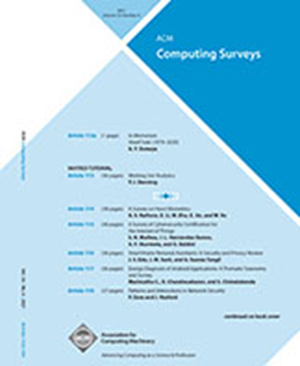Tree-based Models for Vertical Federated Learning: A Survey
IF 23.8
1区 计算机科学
Q1 COMPUTER SCIENCE, THEORY & METHODS
引用次数: 0
Abstract
Tree-based models have achieved great success in a wide range of real-world applications due to their effectiveness, robustness, and interpretability, which inspired people to apply them in vertical federated learning (VFL) scenarios in recent years. In this paper, we conduct a comprehensive study to give an overall picture of applying tree-based models in VFL, from the perspective of their communication and computation protocols. We categorize tree-based models in VFL into two types,基于树的垂直联邦学习模型:综述
基于树的模型由于其有效性、鲁棒性和可解释性,在广泛的实际应用中取得了巨大的成功,这激发了近年来人们在垂直联邦学习(VFL)场景中应用它们。在本文中,我们进行了全面的研究,从它们的通信和计算协议的角度,给出了在VFL中应用基于树的模型的整体图景。本文将基于树的VFL模型分为特征收集模型和标签散射模型两类,并详细讨论了它们的特点、优势、隐私保护机制和应用。本研究还重点研究了基于树的模型在VFL中的实现,总结了几种设计原则,以便更好地满足学术研究和工业部署的各种需求。我们进行了一系列实验,对不同类型的基于树的模型的差异和进展进行了实证观察。
本文章由计算机程序翻译,如有差异,请以英文原文为准。
求助全文
约1分钟内获得全文
求助全文
来源期刊

ACM Computing Surveys
工程技术-计算机:理论方法
CiteScore
33.20
自引率
0.60%
发文量
372
审稿时长
12 months
期刊介绍:
ACM Computing Surveys is an academic journal that focuses on publishing surveys and tutorials on various areas of computing research and practice. The journal aims to provide comprehensive and easily understandable articles that guide readers through the literature and help them understand topics outside their specialties. In terms of impact, CSUR has a high reputation with a 2022 Impact Factor of 16.6. It is ranked 3rd out of 111 journals in the field of Computer Science Theory & Methods.
ACM Computing Surveys is indexed and abstracted in various services, including AI2 Semantic Scholar, Baidu, Clarivate/ISI: JCR, CNKI, DeepDyve, DTU, EBSCO: EDS/HOST, and IET Inspec, among others.
 求助内容:
求助内容: 应助结果提醒方式:
应助结果提醒方式:


